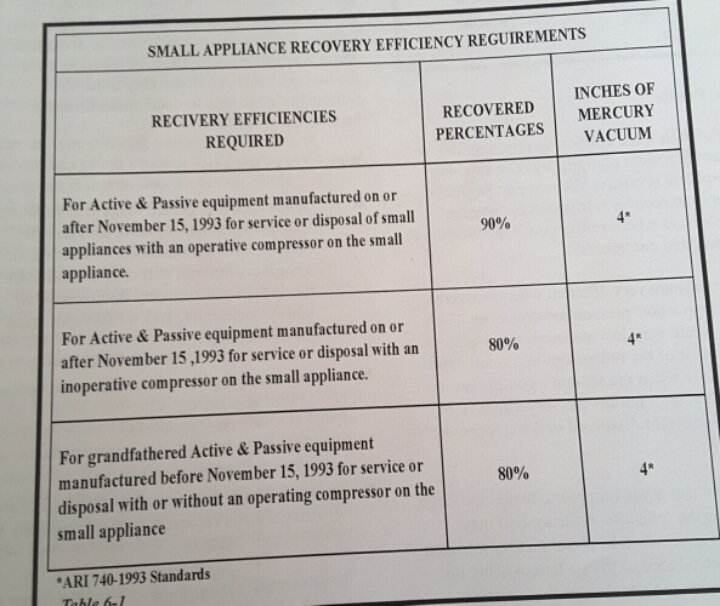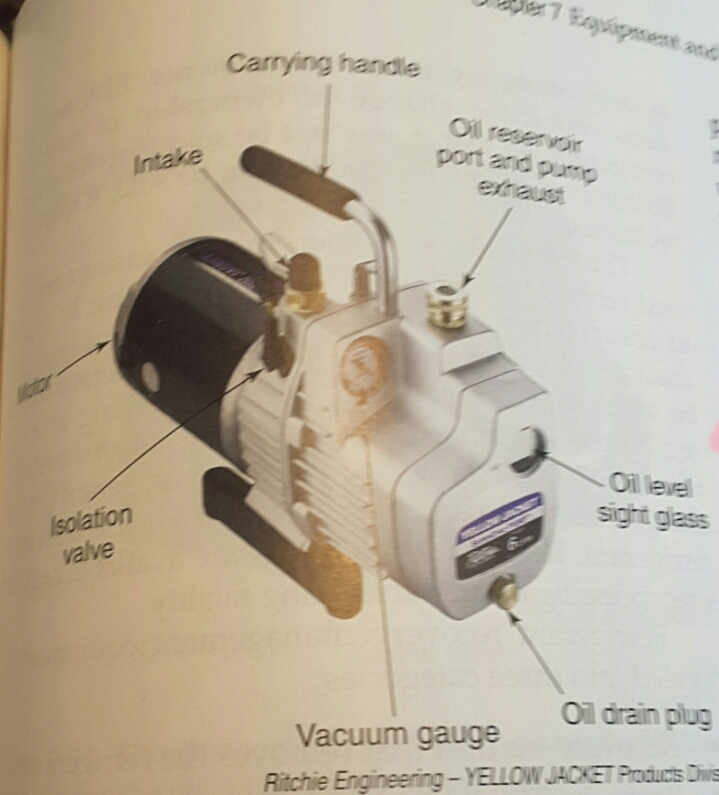[스크랩] 하이라이트 6 th Edition (* 8편 ): Online Learning Class.
* 진공펌프 / Vaccum Pump.
Because of their internal construction, vaccum pump cannot handle pumping against anything but atmospheric pressure. Vaccum pumps should be used only to recover refrigerant in " passive " recovery devices where refrigerant is recovered into " non-pressurized " containers.
(* 시험보실때 제일 많이 틀리시는 종목이기도 하며 많은 회원님들 오해로 피해를 제일 많게 보는 종목이기도 합니다 )
진공펌프의 내부조사항으로 대기압이상의 압력의 경우 상할 염려가 많기에 항상 간접적인 회수 방법중 회수컨테이너/탱크의 내부압력을 되도록 낮은 진공을 하여 회수 할수 있도록 하여야 합니다.
진공펌프는 냉매오일에 섞여있는 냉매를 분리할수 있는데 중요역할을 하며 배관내에 수분이 존재할경우 질소개스 주입으로 분리할수 있도록 하기도 합니다.
진공작업중 콤프가동은 모터에 고열을 수반하기에 가동 하지않아야 하며 이유는 냉매순환으로 모터를 식혀주기 때문이기도 합니다.
* When not to recover:
(* 새로운 SNAP 규정에 따른 변동사항이 포함되여 있기에 기존하는 자격증소지하신 회원들의 주의가 요구되는 사항이기도 합니다. )
▪ When access is gained and the system is found to be at atmospheric pressure// 0 psig. This is indication of a leak and recovery attempt will only contaminate the system and the recovery device with air, non-condensibles, water vapor from the atmosphere.
(* 게이지 설치시에 0 psig 를 발견하게 되면 더이상 회수를 하지 않으며 기타 이물질이나 불응측성 물질이 회수 되지 않도로 합니다. )
▪ Any small appliances manufactured before 1950 if containing;
• Sulfur dioxide.
• Methyl chloride.
• Methyl formate.
▪ Refrigerant found in absorption systems in campers and recreational vehicles such as
• Water.
• Ammonia.
• Hydrogen.
▪ When refrigerant mixed with Nitrogen as trace gas for electronic leak checking. In this case, the mixture of Nitrogen and refrigerant can be VENTED to the atmosphere because the trace gas is NOT used as refrigerant.
(* 시험에 빠지지 않고 나오는 사항입니다.
1950년이전에 제조된 공조기에 들어있는 , 혹은 캠퍼나 레크리에이션 자동차에 설치된 흡수형 공조기의 내용 물질들도 회수하지 않아도 됩니다.
질소개스를 사용하여 냉매누설검증시에 혹은 사용후에는 대기배출을 허용하기로 합니다. )
NOTE:
▪ When nitrogen is used as holding charge, can be vented to the atmosphere.
▪ When strong acidic or pungent odor is detected when servicing or accessing a small appliance. Theses are sure sign of a compressor burntout and the recovery equipment can be damaged and/or contaminated.
* Recovery Requirement and Levels.
In facr, any recovery equipment used for SMALL APPLIANCES which has been manufactured on or after November 15, 1993 must be certified by an EPA approved laboratory.
// Within 20 days of opening a new business, you must register/or certify to the EPA that you have recovery equipment that is able to recover at least 80% of refrigerant charge ,or achieve a 4 inch mercury vaccum under ARI Standards.
(* 작은 공조기에 사용할 냉매회수기는 1993년11월 15일을 전후하여 EPA의 인증을 받아야 하며 새로히 비지네스 시작 20일 이내에 80%/4인치 진공을 할수 있는 회수기를 마련하여 EPA에 신고하여야 할 의무가 있읍니다. )
Leak Checking.
The final EPA rule does not address the repair of leaks for small appliance.. In fact, it is not mandatory to repair leaks on small appliances,. However, an environmentally conscious service technician should make every effort to find and repair leak.
Dry nitrogen is the recommended method of leak checking R -134a systems, R-134a is for substitute for R-12 in small appliances, but it is NOT a direct Drop-in refrigerant for R-12.
Wherever dry nitrogen is used for pressurized leak checking, the use of pressure relief valve and pressure regulator must be used on the nitrogen tank.
Always check the design low side test pressure on the system's data name plate before pressurizing a system with dry nitrogen. Never exceed this value.
* 아세요* ?
미주 환경청의 마지막 결론은 5파운드 미만이 들어가는 작은 공조기의 누설 수리는 법적 으로 하지 않아도 되나 도의적인 책임상 누설수리 및 회수를 하여 환경을 보호 하여야 할 의무를 갖게 됩니다.
R-134a 냉매는 R-12를 대체할수 있는 냉매로 인정 받으나 바로 교체/충전하여 사용할수 없으며 (* No- direct drop in )
질소를 사용하여 압력 검증 및 누설 검증후에는 대기로 배출 하여도 가능하나 항상 제품설명서에 써있는 저압 허용치를 넘지 않아야 하며 감압밸브/안전밸브설치를 지키도록 합니다.
Shipping of Refrigerant Cylinders.
When refrigerant or recovery cylinders are being transported in any way, they must be transported in a vertical, upright position.
Refrigerant should never be mixed within the cylinder. When refrigerant are recovered from an appliance, they must be recovered in their own clearly marked cylinders.
(* 냉매탱크를 운반시에 반듯이 세워서 , 냉매회수 탱크에는 한가지 냉매 이상 섞어 쓸수 없으며, 명확한 냉매 종류를 표시하여야 합니다. )
If mixed, the refrigerant must be taken to a reclaimer. The Reclaimer may or may not accept it. If the Reclaimer receives cycle refer of refrigerant that have been mixed, they will either refused to reclaim the refrigerant mixture and return it at the owner's expense, or agree to destroy the refrigerant mixture and charge a fee. It is technician's responsibility to correctly handle the mixed refrigerants and not vent it to atmosphere.
(* 만약에 섞인 냉매가 있다면 재생 하는 곳에 보내여 새것과 같은 작업을 할수도 있으나 섞인 냉매를 재생 하려고 하는 곳에서 받아드리지 않을수도 있으며 폐기 처분하거나 재생에 대한 모든 비용은 소비자에게 요구할수도 있으며 경우에 따라서는 거절할 수도 있읍니다 .
Refrigerant that is returned to a Reclaimer must have a label identifying the type of refrigerant in the cylynder.
The shipping cylynder must be properly Labeled and tagged to meet local, state and federal regulations. Recovery cylinders must be colored gray with a yellow shoulder.
▪ Have proper lebeling.
▪ Meet Department of Transportation Standards.
▪ Have the proper shipping paperwork which specifies the NUMBER OF CYLINDERS of each gas.
Disposal of Small Appliance and disposal cylinders.
▪ Recovered remaining refrigerant from appliance.
▪ Verify by a signed statement from whom you obtained the appliance that the refrigerant has been recovered. The date of recovery is also needed.
When technician is finished using a disposable cylinder, the residual vapor in the cylinder must be recovered.
The valve should then be removed and the tank marked empty. The cylinder should then be sent to a metal scrapper. The reuse of a disposal cylinder is illegal.
Safety;
Because refrigerant is heavier than air, they can displace the air, and cause suffocation.
Self Contained Breathing Apparatus (* SCBA ) must be used if persons are exposed to large refrigerant leaks, spills, or dangerous concentrations.
If no Self Contained Breathing Appratus is available, the refrigerant leaks or spill area be vacated, ventilated.
Active recovery devices may generated high pressure conditions if there is excessive air in the recovery cylinder, non-condensibles gases in the refrigerant being recovered or the the recovery cylinder inlet valve is not opened.
Safety goggles or glasses and butyl-lined gloves must be worn when operating recovery devises especially when connecting or disconnecting hoses.
When refrigerants are exposed to high temperatures such as hot flames or metals, CFC, HCFC, and HFC refrigerant can dispose of HYDROCHLORIC and Hydrofloric acids and Phosegen gas.
When leak checking, never pressurized a system with Oxygen or compressed air, can be generated to the point of explosion.
Nitrogen is the most popular gas that can be safely used to pressurize test a system when refrigerants and oils are present.


